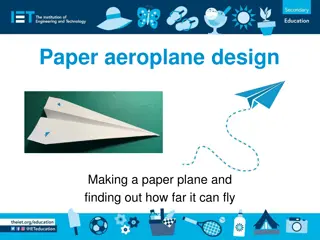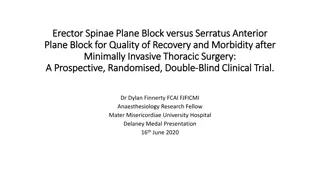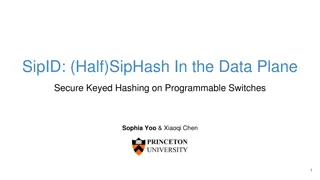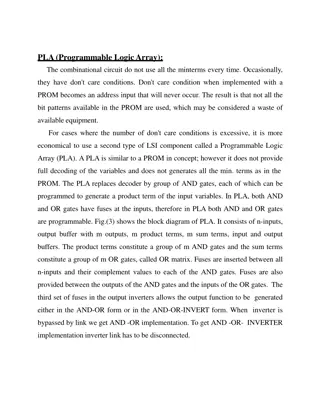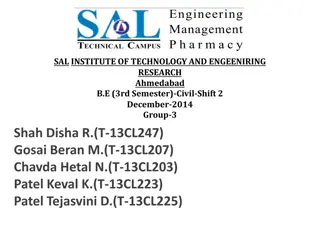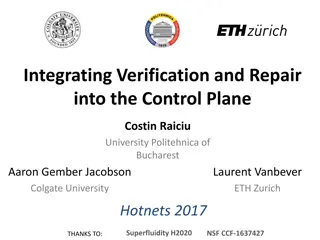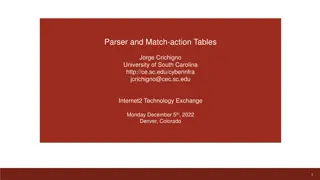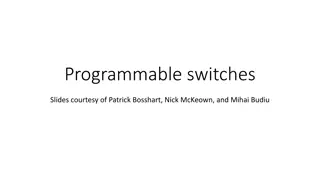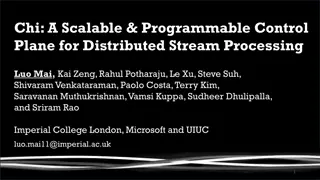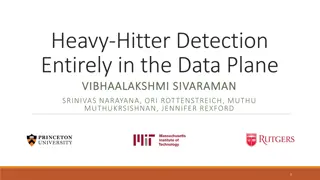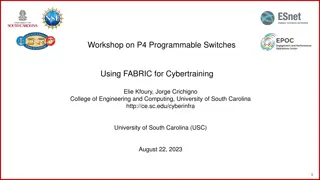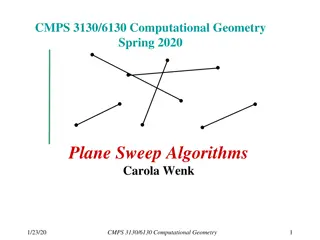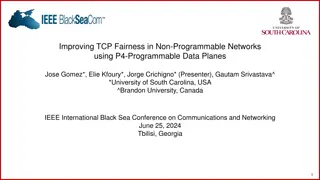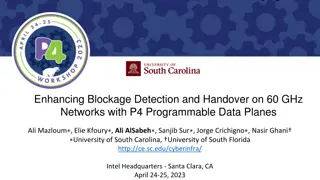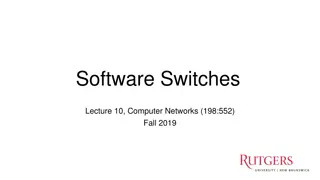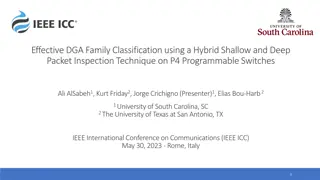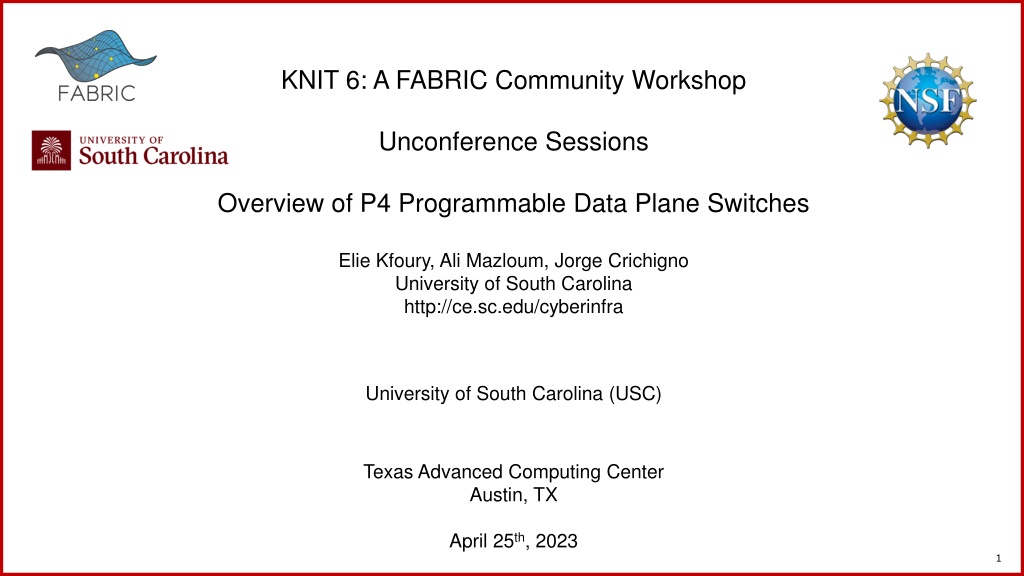
Overview of P4 Programmable Data Plane Switches in Networking
Discover the evolution from traditional networking to Software-Defined Networking (SDN) to P4 programmable switches in this informative session. Learn about the potential impact of P4 switches in customizing packet processing functions, defining new protocols, and offloading applications to the data plane for enhanced network performance.
Download Presentation

Please find below an Image/Link to download the presentation.
The content on the website is provided AS IS for your information and personal use only. It may not be sold, licensed, or shared on other websites without obtaining consent from the author. Download presentation by click this link. If you encounter any issues during the download, it is possible that the publisher has removed the file from their server.
E N D
Presentation Transcript
KNIT 6: A FABRIC Community Workshop Unconference Sessions Overview of P4 Programmable Data Plane Switches Elie Kfoury, Ali Mazloum, Jorge Crichigno University of South Carolina http://ce.sc.edu/cyberinfra University of South Carolina (USC) Texas Advanced Computing Center Austin, TX April 25th, 2023 1
Workshop Resources Webpage with PowerPoint presentations: http://ce.sc.edu/cyberinfra/knit6.html Hands-on sessions: to access labs for the hands-on sessions, use the following link: https://netlab.cec.sc.edu/ Credentials provided on-site Username: guest1, guest2, Password: nsf2023 (all lowercase) 2
Traditional (Legacy) Networking Since the explosive growth of the Internet in the 1990s, the networking industry has been dominated by closed and proprietary hardware and software The interface between control and data planes has been historically proprietary Vendor dependence: slow product cycles of vendor equipment, no innovation from network owners A router is a monolithic unit built and internally accessed by the manufacturer only 3
SDN Protocol ossification has been challenged first by SDN SDN (1) explicitly separates the control and data planes, and (2) enables the control plane intelligence to be implemented as a software outside the switches The function of populating the forwarding table is now performed by the controller 4
SDN Limitation SDN is limited to the OpenFlow specifications Forwarding rules are based on a fixed number of protocols / header fields (e.g., IP, Ethernet) The data plane is designed with fixed functions (hard-coded) Functions are implemented by the chip designer 5
P4 Programmable Switches P41 programmable switches permit a programmer to program the data plane Define and parse new protocols Customize packet processing functions Measure events occurring in the data plane with high precision Offload applications to the data plane 1. P4 stands for stands for Programming Protocol-independent Packet Processors 6
P4 Programmable Switches P41 programmable switches permit a programmer to program the data plane Define and parse new protocols Customize packet processing functions Measure events occurring in the data plane with high precision Offload applications to the data plane Reproduced from N. McKeown. Creating an End-to-End Programming Model for Packet Forwarding. Available: https://www.youtube.com/watch?v=fiBuao6YZl0&t=4216s 7
P4 Programmable Switches Parser Program Header and Data Declarations Tables and Control Flow table port_table { } header_typeethernet_t { } header_typel2_metadata_t { } parser parse_ethernet { extract(ethernet); returnswitch(ethernet.ethertype) { 0x8100 : parse_vlan_tag; 0x0800 : parse_ipv4; 0x8847 : parse_mpls; default: ingress; } control ingress { apply(port_table); if (l2_meta.vlan_tags == 0) { process_assign_vlan(); } } header ethernet_t ethernet; header vlan_tag_t vlan_tag[2]; metadata l2_metadata_t l2_meta; Memory ALU Programmable Parser Programmable Match-Action Pipeline 8 Reproduced from N. McKeown. Creating an End-to-End Programming Model for Packet Forwarding. Available: https://www.youtube.com/watch?v=fiBuao6YZl0&t=4216s 8
Libraries A library consists of between 10-20 lab experiments Each lab experiment includes a detailed, step by step manual Once a learner completes all experiments, the learner acquires significant knowledge and hands-on expertise, and may earn an academic credential or certificate Information about libraries are available at http://ce.sc.edu/cyberinfra/cybertraining.html 9
Library on Introduction to P4 with BMv2 Experiments Exercises Lab 1: Introduction to Mininet Lab 2: Introduction to P4 and BMv2 Lab 3: P4 Program Building Blocks Lab 4: Parser Implementation Lab 5: Introduction to Match-action Tables (Part 1) Lab 6: Introduction to Match-action Tables (Part 2) Lab 7: Populating / Managing Match-action Tables Lab 8: Checksum Recalculation and Deparsing Exercise 1: Building a Basic Topology Exercise 2: Compiling and Testing a P4 Program Exercise 3: Parsing UDP and RTP Exercise 4: Building a Simplified NAT Exercise 5: Configuring Tables at Runtime Exercise 6: Building a Packet Reflector 10
Library on P4 Applications, Stateful Elements, and Custom Packet Processing Experiments Lab 1: Introduction to Mininet Lab 2: Introduction to P4 and BMv2 Lab 3: P4 Program Building Blocks Lab 4: Defining and processing custom headers Lab 5: Monitoring the Switch s Queue using Standard Metadata Lab 6: Collecting Queueing Statistics using a Header Stack Lab 7: Measuring Flow Statistics using Direct and Indirect Counters Lab 8: Rerouting Traffic using Meters Lab 9: Storing Arbitrary Data using Registers Lab 10: Calculating Packets Interarrival Time w/ Hashes and Registers Lab 11: Generating Notification Messages from the Data Plane 11
Library on Security Applications with P4 Experiments Lab 1: Introduction to Mininet Lab 2: Introduction to P4 and BMv2 Lab 3: P4 Program Building Blocks Lab 4: Parser Implementation Lab 5: Introduction to Match-action Tables Lab 6: Implementing a Stateful Packet Filter for the ICMP protocol Lab 7: Implementing a Stateful Packet Filter for the TCP protocol Lab 8: Detecting and Mitigating the DNS Amplification Attack Lab 9: Identifying Heavy Hitters using Count-min Sketches (CMS) Lab 10: Limiting the Impact of SYN Flood by Probabilistically Dropping Packets Lab 11: Blocking Application Layer Slow DDoS Attack (Slowloris) Lab 12: Implementing URL Filtering through Deep Packet Inspection and String Matching 12
Library on Network Measurement Apps with P4* Experiments Lab 1: Introduction to Mininet Lab 2: Introduction to P4 and BMv2 Lab 3: P4 program building blocks Lab 4: Defining and processing custom headers Lab 5: Monitoring the switch s queue using standard metadata Lab 6: Detecting microbursts and identify flows contributing to the queue Lab 7: Measuring flow statistics using direct and indirect counters Lab 8: Flow rate measurement and traffic policing using meters Lab 9: Identifying elephant flows using count-min sketches (CMS) Lab 10: Using In-band Network Telemetry (INT) to track the path taken by packets Lab 11: Measuring the round-trip time of flows Lab 12: Measuring the packet loss rate Lab 13: Measuring packets inter-arrival times Lab 14: Identifying TCP congestion control type using inter-arrival measurements Lab 15: Plotting measurements from P4 on a Grafana dashboard * Expected by July 2023 13
Library on P4 Programmable Data Plane with Tofino Experiments Lab 1: Introduction to P4 and Tofino Lab 2: Introduction to P4 Tofino Software Development Environment Lab 3: Parser Implementation Lab 4: Introduction to Match-Action Tables Lab 5: Populating and Managing Match- Action Tables at Runtime Lab 6: Checksum Recalculation and Packet Deparsing 14
Organization of the Lab Manuals Each lab starts with a section Overview Objectives Lab topology Lab settings: passwords, device names Roadmap: organization of the lab Section 1 Background information of the topic being covered (e.g., fundamentals of perfSONAR) Section 1 is optional (i.e., the reader can skip this section and move to lab directions) Section 2 n Step-by-step directions 15
This work is supported by NSF award number 2118311 For additional information, please refer to http://ce.sc.edu/cyberinfra/ Email: jcrichigno@cec.sc.edu, ekfoury@email.sc.edu 16



